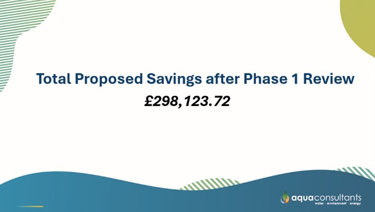Northumbria Integrated Drainage Partnership project with Northumbrian Water
Case study
Client: Northumbrian Water Limited
Scheme Value: c.£50m
Fee Value: c.£75k per project over 16 months project duration
Start Date: Jan 2024
End Date: May 2025
Project Lead: Elaine Smith – NWL PM
Project Team: Simon Wiley NEC PM, Catherine Hagerman QS
Partners: Environmental Authority, Local County Councils
Services: NEC Project Management, Commercial Support
Problem / Opportunity
Northumbrian Water Limited (NWL) is a prominent water company in the United Kingdom, delivering essential mains water and sewerage services across the English counties of Northumberland, Tyne and Wear, Durham, and portions of North Yorkshire.
Aqua Consultants were tasked by NWL to support a pivotal scheme known as the Northumbria Integrated Drainage Partnership (NIDP) which is an initiative that encompasses a total of 20 planned projects over the next 16-months.
The scheme's primary aim is two-fold: firstly, to mitigate the risk of flooding from surface water and combined drainage systems, and secondly, to deliver wider benefits. These benefits include strategic improvements to drainage systems, targeted investments, alignment with ongoing redevelopment endeavours, and enhancements to local biodiversity, habitats, and green infrastructure across multiple priority locations within the NWL operating region.
Whilst considering this, the Leas project in Sedgefield emerged as the prime candidate for a collaborative and initial study, owing to the comprehensive data accessible from both NWL flood reports and Environment Agency (EA) surface water flood risk maps. This data was instrumental in revealing the potential flood hazards posed to the properties in this area from surface water and adjacent watercourses.
The preferred solution included the installation of a new relief surface water sewer and a new relief combined sewer aimed at mitigating flood risks originating from the sewerage system. Additionally, this option incorporated the implementation of rain gardens designed to capture highway runoff, thereby diminishing peak flows into the sewerage system. These rain gardens not only serve the purpose of flood mitigation but also offer broader advantages, such as enhancing biodiversity and amenity for residents.
Solution
The Aqua team on this project comprised a Senior NEC Project Manager and an Assistant Quantity Surveyor. Their initial responsibilities included assessing the proposed programme and target cost for the preferred solution which was submitted by the Principal Contractor Esh-Stantec. This evaluation aimed to enhance the project's initial outlook and identify any opportunities for improved affordability and efficiency on behalf of the Client.
The task was split into three phases:
Phase 1 - Conduct a comprehensive desktop study aimed at identifying potential efficiencies and cost savings within the target costs.
During this phase, our focus was on conducting a high-level examination of the proposed costings to help pinpoint areas requiring further approval from the Client. Leveraging our industry expertise, we flagged any items that appeared to exceed industry norms. We then requested substantiation in the form of quotes or detailed price breakdowns to provide the Client with a more comprehensive understanding, enabling them to challenge suppliers or methodologies where necessary.
Furthermore, we scrutinised time-based items from a programme perspective. By reassessing the site compound location, we aimed to minimise travel time between the compound and the site, thereby increasing productivity and reducing overall project duration and costs.
Phase 2 - Conduct an iMod report benchmark against industry standards.
Benchmarking is a comparative analysis approach which provides a high-level view of activity within a cost estimate. Three, top-down methodologies are used to create a range of comparable benchmark values for delivery. By using the iMod costings provided by the Client, Aqua can de-construct the cost build ups of the project by applying industry knowledge to indicate if NWL’s initial estimate was within the expected tolerances for a project with this scope.
The benchmark findings are indicative of a project’s cost certainty. If the costings are found to sit outside of the expected range for a project of this scope, there may be efficiencies and savings to be realised. A delta can be calculated between the target price and benchmark value which will provide further indication on cost certainty.
Phase 3 - Conduct a target cost comparison against the benchmark.
Once the iMod benchmark has provided indicative figures of cost certainty, a comparison can be made between the Contractor’s quote and the benchmark. This will highlight items within the quote which could be challenged by the Client for improved efficiencies and affordability.
Phases 2 and 3 will provide insight into whether the Contractor’s target costings are in line with the industry standards and feasibility estimates, or if other Contractors should be invited to tender for this scheme.
Outcome

Shared Capability
Aqua promptly responded to a critical client request by producing a tender assessment report to identify opportunities for enhanced project affordability. With a dedicated Project Manager and Quantity Surveyor leading the effort, Aqua were able to utilise a wealth of collective skills, expertise, and industry experience to deliver a more realistic cost forecast to the client. This also helped streamline the application process for external funding from the Environment Agency and Local Council. Furthermore, this report has been used a basis for further discussions with Principal Contractors to ensure that future target costs are in line with Client expectations.
Latest case studies
 Case study
Case studyWorking with RAPID to improve Ofwat’s understanding of water infrastructure costs
 Case study
Case studyIndependent review of Sydney Water's LTCOP for their IPART submission
 Case study
Case studyRegional risk assessment and prioritisation of invasive non-native species management for raw water transfers
 Case study
Case studySTEM project to increase biodiversity at Allerton CofE Primary School
Here to solve your biggest challenges and grow sustainable value
Our expert consultants are available to broaden your thinking, lead transformation, and help you achieve successful outcomes.
Contact our experts

